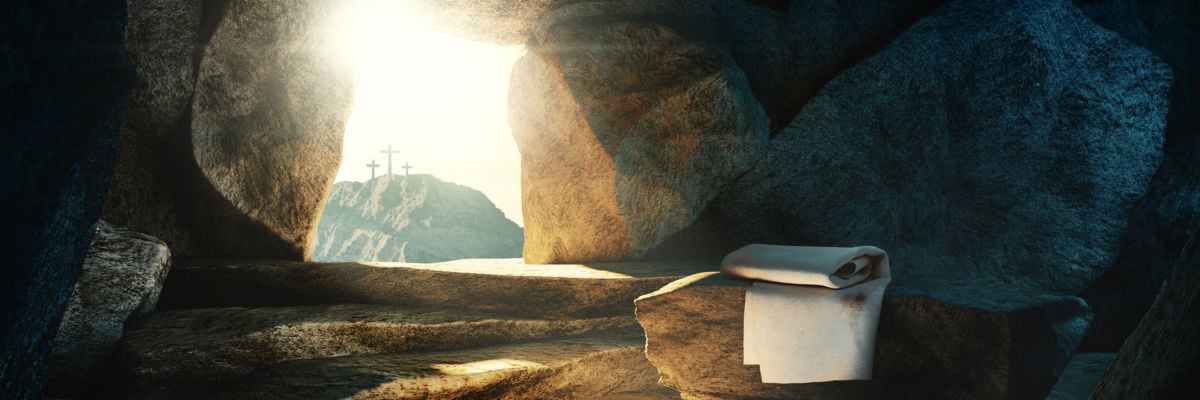
In this video, Holy Land tour guide and author Steve Ray gives an inside look at the Church of the Holy Sepulcher, on a special Holy Week segment. Host Cy Kellett joins him to explore the historical and spiritual significance of the tomb of Jesus, the crucifixion site at Golgotha, and the surrounding garden.
Transcript:
Steve: Just so you’ll know, this is the church. See if I can do this right. This is the church of the Holy Sepulcher. Today, what it looks like today, okay, people go in there and say, that doesn’t look like a hill and a garden and a tomb, but this is what it looked like at the time of Jesus. See, there’s a little hill there where the cross was. And see, carved into the hill is a tomb. And then Queen Helena came, and she cut that all away and built this church over it, which was the size, I hear, of three football fields. And then that’s what it looks like today. Built over both. Under the big dome is the tomb. Under the other dome there is the cross, all under one roof. And since we’re showing pictures, here is what it looks like. If you were to walk upstairs right now, there would be no people there. Just like that. But that is up a level. Up. You have to go upstairs. That’s Calvary, and that is an altar. And when you reach down, like Janet and I are doing here, which we’ve done a hundred times or more, when you reach down and you touch the stone under that altar, okay, I tell my group, your hand, if you touched it 2,000 years ago, your hand would come up sticky with his blood.
Cy: Oh, my.
Steve: That’s what you’re touching, the top. And people go down and they touch it, and they just cry. And at the top, right next to that stone where the blood was, is this image. Look at that. Isn’t that haunting? That’s Mary watching her son be crucified. And Simeon the Prophet had told her, a sword will pierce your soul also. And that picture just gives me goosebumps. It’s not a picture, actually. It’s a glass bust, like a statue inside glass. And it never ceases to. Hair stands up on the back of my neck. I get chills. But those are just a few. Just to get us started as to the physical place. It’s really there.
Cy: Yeah. That’s extraordinary, that. I mean, this is the story of Jesus. It’s always, you know, in the scriptures, they’re careful to tell us what year in the reign of what emperor and all these details and who was the governor and all that. And all of it checks out. There’s one that people have a little bit of trouble with, the governor of Syria, but there’s no reason to have trouble with that. But people do. But historically and archaeologically, it all checks out. But tell me a little bit about Helena, if you would. Christ is crucified probably in the year 30 AD and she gets there maybe 300 years after that. Just about 300 years after that.
Steve: Okay, so the sequence.
Cy: Yes, go ahead.
Steve: The sequence is Jesus is crucified on that hill called Golgotha. Calvary is a Latin for it. I find it interesting that all the Protestants have Calvary Baptist Church. They take that right out of the Latin Vulgate of the Catholic Church. That’s where you find the word Calvary. It’s the only place it is. But anyway. And he’s buried on top of there and it says that it’s in a garden. And they just have released information that they did archaeological testing underneath. And they found the remains of grapevines and olive trees. It really was a garden under there. And then they had into the rock the tomb cut. The early Christians came and they prayed there and they worshiped there and they never forgot that place.And then Emperor Hadrian came along in 135 and he built pagan shrines over these holy sites to obliterate them, to erase them from the face of the earth. So over the place of the holy Sepulcher was built a pagan temple to Venus.
Cy: Yeah
Steve: So now that stood there until 320. So for over 200 years, there you’ve got. Nobody could go and see it. It’s a pagan temple. Then Queen Helena came after her son Constantine legalized Christianity in 313. And she came and she saw. I’m making this up, but this is how I imagine it happening. She found a little local boy and she said, little boy, where was Jesus crucified and buried? And he took the queen by the hand. He says, come with me, come with me. And he took her over. He said he was crucified and buried and rose again right under that pagan temple to Venus. And so she knocked it down, dug underneath, and guess what she found? She found the tomb, she found the cross. She actually found the cross that today you can go down. It’s a long stair down. It’s called the Chapel of Helena. And there was a bunch of old crosses that had been thrown in there and forgotten. So she brought a bunch of sick people and she touched all of them. And the one that healed everybody she touched, she said, this must be the true cross. And that’s where we get. Like sometimes you see a relic of the true cross. And it’s from Helena’s cross that she discovered there. And so then she built this beautiful, beautiful church over that. And it’s been there ever since. And we’ve never forgotten where it was ever since. The same story I could tell you about Bethlehem over the cave where he was born. In Bethlehem also Hadrian built there. She knocked it down, found the place. So these Hadrian, I love it when the devil gets his plans foiled and ends up finding out he’s helping God instead of hurting God. He’s going to obliterate all these holy sites. All he did was mark them for future generations.
Cy: Oh, that’s a very good point.
Steve: When Helena came. De marked them all. There were like four of these pagan shrines. Under those are the holy sites. Dug them up, built beautiful churches, and we’ve been going there ever since.
Cy: So you can make a pilgrimage there now, but you would say, say in the year 150 or something. Do you think Christians made pilgrimages there even though it was under a temple?
Cy: Oh, yeah, they made pilgrimages early on. And I have a book here called *Egeria’s Journals*. She went in 381 and she wrote her records. But there are other. Justin Martyr, for example, he was second century and he said, and him and John Chrysostom, third century, said that pilgrims come even at this late date to view the places where Jesus was crucified. So he said that when you go to Nazareth, they still have some of the things that Jesus and Joseph made because his families would have kept those things. And they still remembered that I was a great, great, great grandson of, you know, Jesus’ uncle. And so there’s records even way back of pilgrims going there.
Cy: So where Jesus was crucified, how far outside the walls of Jerusalem is that? And how near is it to the gates entering and exiting ancient Jerusalem?
Steve: It would have been right outside the city gates. And this is an interesting thing because the Protestants came along and I don’t mean to, you know, I was one of them once and my parents made me take them. When I took them, they wanted to go see the garden tomb because the Anglicans in 1850, so it was like 150 years ago or two. General Gordon didn’t like the Holy Sepulcher because it was too Catholic and it was inside the city walls. And he said, but the Bible says it was outside the city walls. So he went outside the city walls, looked, he found an old tomb. And above it, it was a quarry, so it looked like you could make out of it a little bit like a skull. He said, this must be it. So they bought that land. And the Protestants, the fundamentalists, they go there and they say, this is the garden tomb where Jesus was really crucified and buried, but it wasn’t even thought of until 150 years ago.
But the thing is that he didn’t do his homework because at the time of Christ, Calvary was outside the city walls. In 44 AD, they built the walls further out, which then encompassed it. But at the time of the crucifixion, it was outside. So when I tell my story, I give a talk called the Stations of the Cross, where I go through each one of the stations and describe it medically, historically, geographically. And I said, it says Jesus fell the third time. It doesn’t say he fell the third time. But if you’ve been beat up like he was and you’re carrying £110 on your back, stumbling through these streets, you got blood in your eyes, you can’t even see, of course he’s going to fall. But I just say that to answer your question, at Jesus’ time, when he’s going outside the gates, he fell and he had that cross on his back and Cleopas, I mean Simeon, was helping him carry it. And I think Jesus looked up and he saw, there’s. That’s where I’m going. Right there outside the gates, there it was.
Cy: Oh, I see. And this was not a unique event. This is where they crucified people. It was a billboard. When you drive into Houston or San Diego or any of these places, there’s billboards. What are they doing? They’re telling you something you need to know before you come into the city. Right.
Cy: Well, the Romans, they crucified people at the city gates, right? On the main thoroughfare, right? Coming in, because it was a billboard that said, here’s what will happen to you if you defy the power of Rome. And they left men, sometimes on those crosses alive for a week. They kept them alive. And sometimes they would just leave the bodies there until they rotted. And this was the Jews, they didn’t like that. So they quickly got them off. But this is what they did. They would hang them there in the city gates so that they would be a billboard to everyone else, be terrified of Rome and never do anything to violate.
And an article, I got an article coming out, in Catholic Answers magazine. Yep. And my article is, was Jesus crucified naked? It’s going to come out at 8 o’clock Good Friday morning. And we worked on that. And I sent that into him a while ago. But it was the utter degradation, the utter dehumanization of the victim to be hanging there completely naked. You lose control of your bodily functions. You’re there in front of all the people who are in Jerusalem coming in and out. Yeah. And it was not only meant to be painful, it was meant to be the utter humiliating degradation of the human being. And it was a warning to never do that. So it was right outside the city gates, and everybody coming in and out of that major city gate would see Jesus hanging there.
Cy: We’ll talk about who was at the foot of the cross. There’s more people than you might recollect were at the foot of the cross. Steve will go through them with us right after this as we begin Holy Week on Catholic Answers Live.



